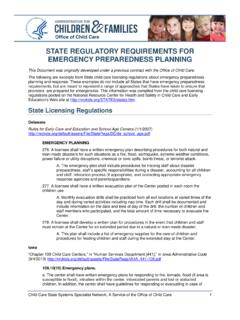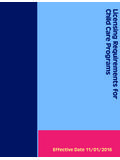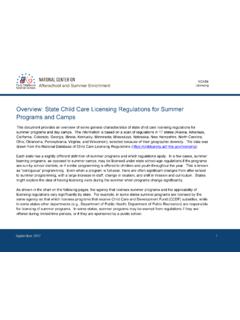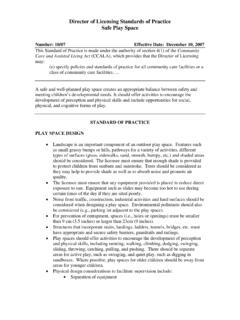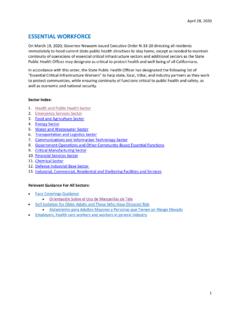Transcription of NURTURING CARE - WHO
1 A FRAMEWORK FOR HELPING CHILDREN SURVIVE AND THRIVE TO TRANSFORM HEALTH AND HUMAN POTENTIALNURTURING CAREFOR EARLY CHILDHOOD DEVELOPMENTIN SUPPORT OFA FRAMEWORK FOR HELPING CHILDREN SURVIVE AND THRIVE TO TRANSFORM HEALTH AND HUMAN POTENTIALNURTURING CAREFOR EARLY CHILDHOOD DEVELOPMENTIN SUPPORT OFNurturing care for early childhood development: a framework for helping children survive and thrive to transform health and human potentialISBN 978-92-4-151406-4 World Health Organization 2018 Some rights reserved. This work is available under the Creative Commons Attribution-NonCommercial-ShareAlike IGO licence (CC BY-NC-SA IGO; ). Under the terms of this licence, you may copy, redistribute and adapt the work for non-commercial purposes, provided the work is appropriately cited, as indicated below. In any use of this work, there should be no suggestion that WHO endorses any specific organization, products or services. The use of the WHO logo is not permitted.
2 If you adapt the work, then you must license your work under the same or equivalent Creative Commons licence. If you create a translation of this work, you should add the following disclaimer along with the suggested citation: This translation was not created by the World Health Organization (WHO). WHO is not responsible for the content or accuracy of this translation. The original English edition shall be the binding and authentic edition .Any mediation relating to disputes arising under the licence shall be conducted in accordance with the mediation rules of the World Intellectual Property citation. World Health Organization, United Nations Children s Fund, World Bank Group. NURTURING care for early childhood development: a framework for helping children survive and thrive to transform health and human potential. Geneva: World Health Organization; 2018. Licence: CC BY-NC-SA (CIP) data. CIP data are available at , rights and licensing. To purchase WHO publications, see To submit requests for commercial use and queries on rights and licensing, see materials.
3 If you wish to reuse material from this work that is attributed to a third party, such as tables, figures or images, it is your responsibility to determine whether permission is needed for that reuse and to obtain permission from the copyright holder. The risk of claims resulting from infringement of any third-party-owned component in the work rests solely with the disclaimers. The designations employed and the presentation of the material in this publication do not imply the expression of any opinion whatsoever on the part of WHO concerning the legal status of any country, territory, city or area or of its authorities, or concerning the delimitation of its frontiers or boundaries. Dotted and dashed lines on maps represent approximate border lines for which there may not yet be full agreement. The mention of specific companies or of certain manufacturers products does not imply that they are endorsed or recommended by WHO in preference to others of a similar nature that are not mentioned.
4 Errors and omissions excepted, the names of proprietary products are distinguished by initial capital reasonable precautions have been taken by WHO to verify the information contained in this publication. However, the published material is being distributed without warranty of any kind, either expressed or implied. The responsibility for the interpretation and use of the material lies with the reader. In no event shall WHO be liable for damages arising from its use. Design and layout: Blossom; Sara in SwitzerlandForewordRoles and responsibilitiesThe health and nutrition sectorThe education sectorThe social- and child -protection sectorsCommitting to action and milestonesAdditional resources363738404244 Making NURTURING care happen05 Table of contentsA framework for NURTURING careWhy this Framework now?What contribution can this Framework make?The audience244415054 Introduction01We know why early childhood development is importantWe know what threatens early childhood development We know that very large numbers of children are at risk of poor developmentWe know that young children need NURTURING care to develop to their full potentialWe know how to support families and caregivers in providing NURTURING careReaching all caregivers and children to meet their needsAnnex 1.
5 GlossaryAnnex 2. Proposed indicators5910 12 17 224748A case for NURTURING care02 VisionTargetsGuiding principles242526 The time to act is now03 Strategic action 1 Strategic action 2 Strategic action 3 Strategic action 4 Strategic action 5 Lead and investFocus on families and their communitiesStrengthen servicesMonitor progressUse data and innovate2829 303132 Five strategic actions04 AnnexesReferencesAcknowledgementsiiiREPO RT 2018iv1 What is one of the best ways a country can boost shared prosperity, promote inclusive economic growth, expand equitable opportunity, and end extreme poverty? The answer is simple: Invest in early childhood in early childhood development is good for everyone governments, businesses, communities, parents and caregivers, and most of all, babies and young children. It is also the right thing to do, helping every child realize the right to survive and thrive. And investing in ECD is cost effective: For every $1 spent on early childhood development interventions, the return on investment can be as high as $13.
6 Early childhood development is also key to upholding the right of every child to survive and now understand that the period from pregnancy to age 3 is the most critical, when the brain grows faster than at any other time; 80% of a baby s brain is formed by this age. For healthy brain development in these years, children need a safe, secure and loving environment, with the right nutrition and stimulation from their parents or caregivers. This is a window of opportunity to lay a foundation of health and wellbeing whose benefits last a lifetime and carry into the next generation. Meanwhile, the cost of inaction is high. Children who do not have the benefit of NURTURING care in their earliest years are more likely to encounter learning difficulties in school, in turn reducing their future earnings and impacting the wellbeing and prosperity of their families and societies. Current estimates are that nearly 250 million children aged under five years in low- and middle-income countries or more than four in every ten risk missing critical development milestones due to poverty or new NURTURING care Framework draws on state-of-the-art evidence on how early childhood development unfolds to set out the most effective policies and services that will help parents and caregivers provide NURTURING care for babies.
7 It is designed to serve as a roadmap for action, helping mobilise a coalition of parents and caregivers, national governments, civil society groups, academics, the United Nations, the private sector, educational institutions and service providers to ensure that every baby gets the best start in Framework builds on the foundation of universal health coverage, with primary care at its core, as essential for all sustainable growth and development. It articulates the important role that all sectors, including the health sector, must play to support the healthy development of all children to develop optimally and reap maximum benefit from pre-school and formal education. As we work together to realize the vision of the 2030 Goals to leave no one behind, we must act urgently now to make investing in early childhood development a priority in every country, every community and every family. On behalf of our organizations, we commit to be part of the movement to create an inclusive and sustainable world, starting with investment in the earliest years to realize the right of each and every child to survive and thrive, to build a more sustainable future for H.
8 Fore Executive DirectorUNICEFA nnette DixonVice President, Human DevelopmentWorld Bank GroupMichelle BacheletChairPartnership for Maternal, Newborn & child HealthTedros Adhanom GhebreyesusDirector-GeneralWorld Health OrganizationForewordREPORT 20182If we change the beginning of the story, we change the whole Global Strategy for Women s, Children s and Adolescents Health (2016-2030)2 is at the heart of the Sustainable Development Its vision is a world in which every woman, child and adolescent realizes their rights to health and well-being both physical and mental. That is a world in which they have social and economic opportunities, and are able to participate fully in shaping prosperous and sustainable societies. And an essential part of this vision is that young children s human rights guarantee them the conditions they need to survive and know why this is important. The period from pregnancy to age 3 is when children are most susceptible to environmental That period lays the foundation for health, well-being, learning and productivity throughout a person s whole life, and has an impact on the health and well-being of the next ,7We know what threatens early childhood development.
9 The biggest threats are extreme poverty, insecurity, gender inequities, violence, environmental toxins, and poor mental All of these things affect caregivers by which we mean parents, families and other people who look after children. The threats reduce these caregivers capacity to protect, support and promote young children s development. We know what children need to develop to their full potential. They need NURTURING care the conditions that promote health, nutrition, security, safety, responsive caregiving and opportunities for early learning. NURTURING care is about children, their families and other caregivers, and the places where they interact. We know what strengthens families and caregivers capacity to support young children s development. An enabling environment is needed: policies, programmes and services that give families, parents and caregivers the knowledge and resources to provide NURTURING care for young children. Community participation is a key part of this environment, which also needs to consider the diversity of children and framework for NURTURING care The NURTURING care Framework provides a roadmap for action.
10 It builds on state-of-the-art evidence about how early childhood development unfolds and how it can be improved by policies and It outlines: why efforts to improve health, well-being and human capital must begin in the earliest years, from pregnancy to age 3; the major threats to early childhood development; NURTURING care refers to conditions created by public policies, programmes and services. These conditions enable communities and caregivers to ensure children s good health and nutrition, and protect them from threats. NURTURING care also means giving young children opportunities for early learning, through interactions that are responsive and emotionally how NURTURING care protects young children from the worst effects of adversity and promotes development physical, emotional, social and cognitive; and what caregivers need in order to provide NURTURING care for young Framework describes how a whole-of-government and a whole-of-society approach can promote NURTURING care for young children.










